SABO SEZ: Keep the Valuables
By Walter Sabo
a.k.a. Walter Sterling, Host
WPHT, Philadelphia, “Walter Sterling Every Damn Night”
TMN syndicated, “Sterling on Sunday”
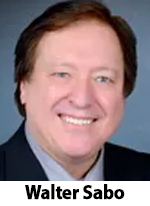 Amazon learned that there are high volume sales for specific categories of products. High demand equals high value to the seller. Items such as diapers, printer ink, staplers, batteries, etc. Being brilliant, Amazon created “Amazon Basics.” Same products, white labeled. Amazon doesn’t manufacture batteries; they just slap their logos on what America needs most. That’s why Mr. Bezos has a bigger boat than you.
Amazon learned that there are high volume sales for specific categories of products. High demand equals high value to the seller. Items such as diapers, printer ink, staplers, batteries, etc. Being brilliant, Amazon created “Amazon Basics.” Same products, white labeled. Amazon doesn’t manufacture batteries; they just slap their logos on what America needs most. That’s why Mr. Bezos has a bigger boat than you.
Radio listeners have high demand for basic elements. The demand for these ingredients is often based on need rather than preference. Needed ingredients delivered by radio represent high value to the radio industry:
– Weather reports
– Traffic reports
– Is everything ok? News reports
– News bulletins
– Local news
– Closings
The first sign of trouble was when radio stations chose to promote a cable channel by presenting “Weather Channel Weather.” Tip: research shows the most respected source of weather is the National Weather Service and a station can pull that for free, any time. No disrespect to the Weather Channel but, can’t radio do weather? Giving away that position to TV is foolish.
Weather is even more important than one might think. Yes, a listener can get it from multiple online sources, but the listener is listening to the radio. The listener needs the weather NOW, live, local. Failing to do weather forces the listener to leave you. (That’s why, on the local and national “Sterling” show, we have meteorologist, Dr. Dave Eiser and Brad Your Grandma’s weatherman presenting the weather through the program.)
Do a Google trend search. Compare WEATHER, SEX, JESUS, TRUMP. Weather will win.
TRAFFIC. An argument I lost was with a 50kw station that had the traffic image because they had a traffic copter. To save $200,000 they were going to take it down. I said, “Fire me but don’t take down the copter.” They took it down. The reason to do traffic is not 100% to give traffic reports, it is – more importantly – to prove that the station is live, and to prove the station sees everything. Breaking news will compel listeners to check with the station that can report it from the air, live!
There is no reason to stop doing traffic and weather because an all-news station is doing it. Those are essential must-have elements for all listeners regardless of format. If we want to own the dashboard, it is best to present top-of-mind information to drivers. Live!
FOX News seems to present a “Bulletin” every few minutes… FOX NEWS ALERT. A radio station doesn’t have to follow the AP Style Guide to define “bulletin.” You can air a bulletin or an alert whenever you want. Urgent, compelling, turn up the radio. Pulling the listener in with sounders, big intros, all that stuff claims your position as the source of better-know-it information.
WHAT HAS HAPPENED. By stripping a station of the costs of bulletins, weather, traffic, and local news we have made radio less valuable. Those “costs” were/are investments in content valued by listeners. Too many stations have trashed essential ingredients for the sake of a false economy. Radio revenues go down each quarter as stations cut costs each quarter.
Walter Sabo has been a C Suite action partner for companies such as SiriusXM, Hearst, Press Broadcasting, Gannett, RKO General and many other leading media outlets. His company HITVIEWS, in 2007, was the first to identify and monetize video influencers.. His nightly show “Walter Sterling Every Damn Night” is heard on WPHT, Philadelphia. His syndicated show, “Sterling On Sunday,” from Talk Media Network, airs 10:00 pm-1:00 am ET, and is now in its 10th year of success. He can be reached by email at sabowalter@gmail.com.



 Conventional industry wisdom: “If our morning star leaves, we’re dead. How could we replace them?”
Conventional industry wisdom: “If our morning star leaves, we’re dead. How could we replace them?” At first, I thought it was a joke. When I realized there were serious people having serious meetings about the joke, it became both horrific and symptomatic
At first, I thought it was a joke. When I realized there were serious people having serious meetings about the joke, it became both horrific and symptomatic As an industry, radio has a peculiar modesty. We diminish our magic and power in relating to listeners and colleagues by using the wrong slang terminology. May I suggest new “labelling” of commonly used radio terms?
As an industry, radio has a peculiar modesty. We diminish our magic and power in relating to listeners and colleagues by using the wrong slang terminology. May I suggest new “labelling” of commonly used radio terms?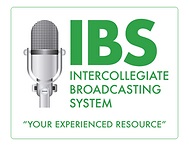 IBS National Conference Set for 2025. The Intercollegiate Broadcasting System (IBS) has announced its annual conference will be coming back to New York City next year. Set for March 7-8, 2025, the nation’s longest running, largest and most important gathering of college radio broadcasters will be held again at the Sheraton Times Square in the heart of Manhattan. Organizers have plans in the works for activities like additional sessions and tours during the day on Thursday, March 6 as well. Early registrants can save big bucks. $109 per person for up to 10 attendees, then the rest of your staff goes for free! This offer ends October 15, (and then prices and group deals go up). TALKERS publisher Michael Harrison, who was a featured speaker at last year’s conference says, “One of the most dynamic scenes in radio today connecting the present with the future is playing out on college campuses across the nation. Professional broadcasters interested in the future of this medium and industry should attend this event. I always come away from it invigorated and inspired.” For more info on IBSNYC 2025, please
IBS National Conference Set for 2025. The Intercollegiate Broadcasting System (IBS) has announced its annual conference will be coming back to New York City next year. Set for March 7-8, 2025, the nation’s longest running, largest and most important gathering of college radio broadcasters will be held again at the Sheraton Times Square in the heart of Manhattan. Organizers have plans in the works for activities like additional sessions and tours during the day on Thursday, March 6 as well. Early registrants can save big bucks. $109 per person for up to 10 attendees, then the rest of your staff goes for free! This offer ends October 15, (and then prices and group deals go up). TALKERS publisher Michael Harrison, who was a featured speaker at last year’s conference says, “One of the most dynamic scenes in radio today connecting the present with the future is playing out on college campuses across the nation. Professional broadcasters interested in the future of this medium and industry should attend this event. I always come away from it invigorated and inspired.” For more info on IBSNYC 2025, please 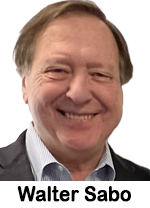 Sterling Shines in Philly. In the first two months since the debut of “Sterling Every Damn Night” on WPHT, Philadelphia, the quirky 9:00 pm – 12:00 midnight talk show hosted by Walter M Sterling (a.k.a. legendary media consultant Walter Sabo) has been gathering jaw dropping metrics. The show has delivered five times the total share of audience 12+ since the same time last year and has proven to be formidably competitive in every key news/talk radio demo. What makes it so interesting on an industry level is its departure from the standard left-right partisan politics that dominates the news/talk format. It covers what is described as “nightly life” – such as the trouble with customer service, in-laws, schools, and romance. What one talks about with their best friends is what the show discusses. Features on the show include listener calls, plus “People of Walmart,” “True Detective Stories,” and new perspectives on current events: Sterling had the first interview with a citizen of Ukraine while bombs were going off, and a Tel Aviv bus driver sharing thoughts on America’s alleged lack of support for Israel. The show is designed for guards up all night in the building lobby, people getting done with second shift, going on third shift, cramming for finals or trying to get the baby to sleep. This is a show that deserves radio industry attention.
Sterling Shines in Philly. In the first two months since the debut of “Sterling Every Damn Night” on WPHT, Philadelphia, the quirky 9:00 pm – 12:00 midnight talk show hosted by Walter M Sterling (a.k.a. legendary media consultant Walter Sabo) has been gathering jaw dropping metrics. The show has delivered five times the total share of audience 12+ since the same time last year and has proven to be formidably competitive in every key news/talk radio demo. What makes it so interesting on an industry level is its departure from the standard left-right partisan politics that dominates the news/talk format. It covers what is described as “nightly life” – such as the trouble with customer service, in-laws, schools, and romance. What one talks about with their best friends is what the show discusses. Features on the show include listener calls, plus “People of Walmart,” “True Detective Stories,” and new perspectives on current events: Sterling had the first interview with a citizen of Ukraine while bombs were going off, and a Tel Aviv bus driver sharing thoughts on America’s alleged lack of support for Israel. The show is designed for guards up all night in the building lobby, people getting done with second shift, going on third shift, cramming for finals or trying to get the baby to sleep. This is a show that deserves radio industry attention. This week, I started a five-night show on Audacy’s WPHT, Philadelphia. Thank you, market president David Yadgaroff. Because of my tenure in the industry, I received a flattering, humbling number of emails from colleagues in radio. THANK YOU. The support and encouragement are appreciated and certainly needed!
This week, I started a five-night show on Audacy’s WPHT, Philadelphia. Thank you, market president David Yadgaroff. Because of my tenure in the industry, I received a flattering, humbling number of emails from colleagues in radio. THANK YOU. The support and encouragement are appreciated and certainly needed! When a new restaurant opens, smart owners put the phone on busy so would-be diners believe the joint is hot, packed and hard to get in to. At street fairs we are drawn to merchant booths with long lines. Crowds give us confidence.
When a new restaurant opens, smart owners put the phone on busy so would-be diners believe the joint is hot, packed and hard to get in to. At street fairs we are drawn to merchant booths with long lines. Crowds give us confidence.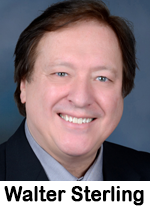 “Walter has demonstrated the importance of the late-night talk radio with his Sunday night nationally syndicated program and has welcomed his listeners, who he refers to as ‘friends on the radio,’ to unpack their day-to-day lives. He’s made strides at ‘Talk Radio 1210 WPHT’ for a decade, and we’re ecstatic to finally bring his entertaining brand to the Delaware Valley five nights a week.” Sterling, who as Walter Sabo operates the Sabo Media Partners consultancy, comments, “Late-night radio is golden media time for a live program. It’s a one-on-one stage for lighter conversations, serving as morning drive for late-shift doctors, nurses, bus drivers, hotel managers, security staff and more. Thank you, David Yadgaroff, Greg Stocker, Jeff Sottolano and the incredible programming and engineering teams at Audacy. Over the years, I’ve made strong connections with Talk Radio 1210 WPHT listeners and look forward to building them as I join weeknights!”
“Walter has demonstrated the importance of the late-night talk radio with his Sunday night nationally syndicated program and has welcomed his listeners, who he refers to as ‘friends on the radio,’ to unpack their day-to-day lives. He’s made strides at ‘Talk Radio 1210 WPHT’ for a decade, and we’re ecstatic to finally bring his entertaining brand to the Delaware Valley five nights a week.” Sterling, who as Walter Sabo operates the Sabo Media Partners consultancy, comments, “Late-night radio is golden media time for a live program. It’s a one-on-one stage for lighter conversations, serving as morning drive for late-shift doctors, nurses, bus drivers, hotel managers, security staff and more. Thank you, David Yadgaroff, Greg Stocker, Jeff Sottolano and the incredible programming and engineering teams at Audacy. Over the years, I’ve made strong connections with Talk Radio 1210 WPHT listeners and look forward to building them as I join weeknights!” Original ideas are golden and rare. Here are five ideas worth stealing because of their novelty, success and oh-wow factor!
Original ideas are golden and rare. Here are five ideas worth stealing because of their novelty, success and oh-wow factor! NO ONE has done more to elevate the status and improve the working conditions of on-air talent as much as Howard Stern.
NO ONE has done more to elevate the status and improve the working conditions of on-air talent as much as Howard Stern. Acknowledging that this publication is fiercely non-partisan and that I – in my role as a broadcaster – am basically the same, I offer the following, not as a political opinion piece, but rather a personal observation based on experience that might shed light on the deeper nature of a large segment of the American population prone to listen to talk radio.
Acknowledging that this publication is fiercely non-partisan and that I – in my role as a broadcaster – am basically the same, I offer the following, not as a political opinion piece, but rather a personal observation based on experience that might shed light on the deeper nature of a large segment of the American population prone to listen to talk radio. Sears used to sell everything. Tractors, tires, insurance, investments, chickens. In 2004, Sears was the dominant retailer in America. By the end of the decade, it was feverishly closing stores and dying.
Sears used to sell everything. Tractors, tires, insurance, investments, chickens. In 2004, Sears was the dominant retailer in America. By the end of the decade, it was feverishly closing stores and dying. Research shows that readers to trade publications like articles with five bullet points. Here are my five bullet points for 2024. If these were to be deployed, you could be thriving by the end of the year. These actions would increase sales and audience share.
Research shows that readers to trade publications like articles with five bullet points. Here are my five bullet points for 2024. If these were to be deployed, you could be thriving by the end of the year. These actions would increase sales and audience share. WHAT WOULD YOU DO? A very good major market DJ murders his wife and injures her lover upon catching them in the marital bed. An 11-year-old girl was in the house – a witness. The murderer is convicted (second-degree murder/“situational crime”) sent to prison, does his time and is released after a few years for good behavior while incarcerated.
WHAT WOULD YOU DO? A very good major market DJ murders his wife and injures her lover upon catching them in the marital bed. An 11-year-old girl was in the house – a witness. The murderer is convicted (second-degree murder/“situational crime”) sent to prison, does his time and is released after a few years for good behavior while incarcerated. Earlier this week, Michael Harrison published his top 10 list of suggestions for being a successful talker. Item number three really caught my eye:
Earlier this week, Michael Harrison published his top 10 list of suggestions for being a successful talker. Item number three really caught my eye: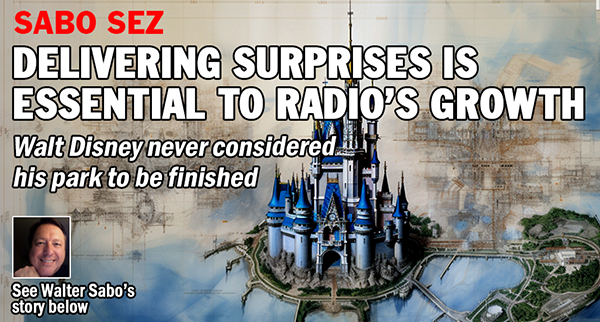
 In May 2007, I was enjoying the brand-new app called YouTube. Still independently owned, still relatively unknown. Some of the videos pulled millions of viewers, more viewers than enjoyed by ESPN or any cable network. More interesting, the videos with high counts were not made by NBC or ESPN or any traditional video source. High view count videos were being made by people with no experience in traditional media, they were experimenters producing in their basements and bedrooms.
In May 2007, I was enjoying the brand-new app called YouTube. Still independently owned, still relatively unknown. Some of the videos pulled millions of viewers, more viewers than enjoyed by ESPN or any cable network. More interesting, the videos with high counts were not made by NBC or ESPN or any traditional video source. High view count videos were being made by people with no experience in traditional media, they were experimenters producing in their basements and bedrooms. As your friends get fired and on-air hosts are replaced with WideOrbit and Profitable Software, the mournful refrain is to unfairly blame consolidation. Consolidation has, in fact, made the medium financially viable and brought hundreds of individual stations from a river of red ink to the glow of black ink. Prior to consolidation, over half the radio stations in the U.S. lost money – year after year. Not a secret stat, those numbers were revealed annually by the NAB.
As your friends get fired and on-air hosts are replaced with WideOrbit and Profitable Software, the mournful refrain is to unfairly blame consolidation. Consolidation has, in fact, made the medium financially viable and brought hundreds of individual stations from a river of red ink to the glow of black ink. Prior to consolidation, over half the radio stations in the U.S. lost money – year after year. Not a secret stat, those numbers were revealed annually by the NAB.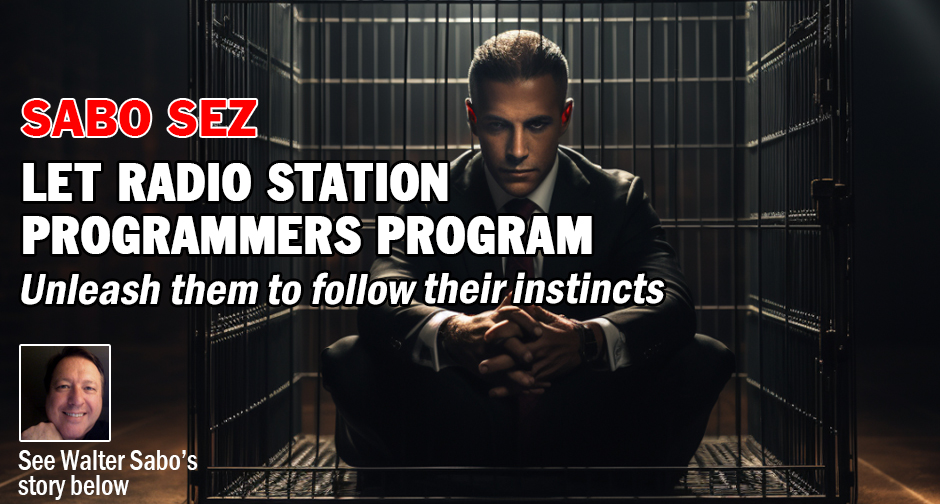
 HALF of all radio stations in the United States lose money – at least they did back in 1991. The NAB used to put out an annual report revealing how many radio stations were profitable. Usually half the stations in America lost money. Since consolidation, the NAB stopped putting out that report. It is reasonable to believe that far, far fewer stations lose money today. Shared costs, real estate, technical economies due to digital equipment versus analog all indicate that there must be fewer money-losing properties.
HALF of all radio stations in the United States lose money – at least they did back in 1991. The NAB used to put out an annual report revealing how many radio stations were profitable. Usually half the stations in America lost money. Since consolidation, the NAB stopped putting out that report. It is reasonable to believe that far, far fewer stations lose money today. Shared costs, real estate, technical economies due to digital equipment versus analog all indicate that there must be fewer money-losing properties. Amazing fact: In ancient times, from 1962-1972, the highest-paid on-air talent in New York City was “an overnight guy.” He was paid salary plus sales response. I’m talking about Long John Nebel on WOR, WNBC, then WMCA. Long John’s live reads moved product because his audience was captive. One-to-one his listeners were attached to their radios in the truck cab, night watchman’s building lobby, parents pacing with their babies, students cramming. His background was not in radio; he was a skilled auctioneer. Obviously, the same listeners exist today – and are anxious for someone to talk to them. Check out this old clip of Nebel in action:
Amazing fact: In ancient times, from 1962-1972, the highest-paid on-air talent in New York City was “an overnight guy.” He was paid salary plus sales response. I’m talking about Long John Nebel on WOR, WNBC, then WMCA. Long John’s live reads moved product because his audience was captive. One-to-one his listeners were attached to their radios in the truck cab, night watchman’s building lobby, parents pacing with their babies, students cramming. His background was not in radio; he was a skilled auctioneer. Obviously, the same listeners exist today – and are anxious for someone to talk to them. Check out this old clip of Nebel in action: 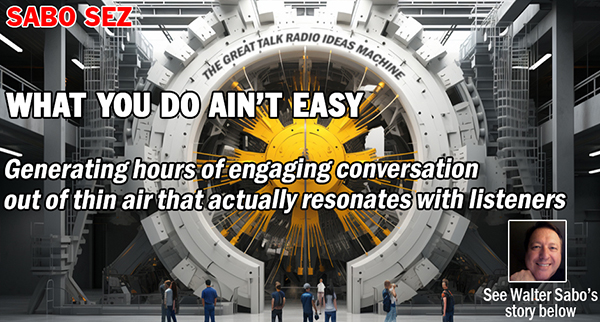
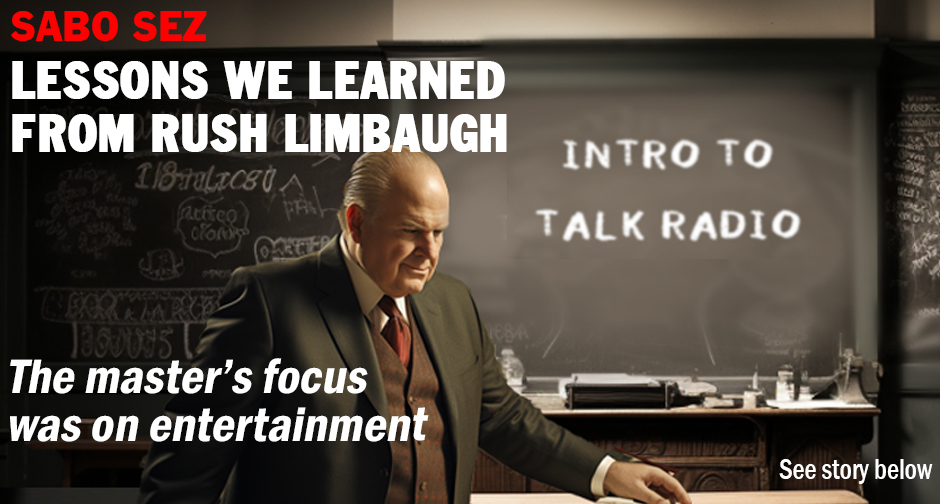
 In the early 1980s, talk radio made a $4 billion mistake. Prior to then, there were approximately 50 full-time talk stations in America. They were predominantly found in major markets and had been in the format since Marconi. The original talk stations had two key traits: They were dominant in ratings and much of their popularity was driven by women hosts.
In the early 1980s, talk radio made a $4 billion mistake. Prior to then, there were approximately 50 full-time talk stations in America. They were predominantly found in major markets and had been in the format since Marconi. The original talk stations had two key traits: They were dominant in ratings and much of their popularity was driven by women hosts.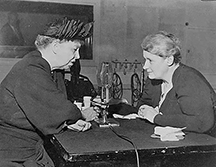 Then Mary Margaret read live copy. OR Mary Margaret had her guests read live copy. Sales for advertisers exploded. (Source: It’s One O’ Clock, Time for Mary Margaret McBride by Susan Ware
Then Mary Margaret read live copy. OR Mary Margaret had her guests read live copy. Sales for advertisers exploded. (Source: It’s One O’ Clock, Time for Mary Margaret McBride by Susan Ware  Last week I had the privilege of moderating a panel at the TALKERS conference. Confession: I listen to speech patterns and tones more than words.
Last week I had the privilege of moderating a panel at the TALKERS conference. Confession: I listen to speech patterns and tones more than words.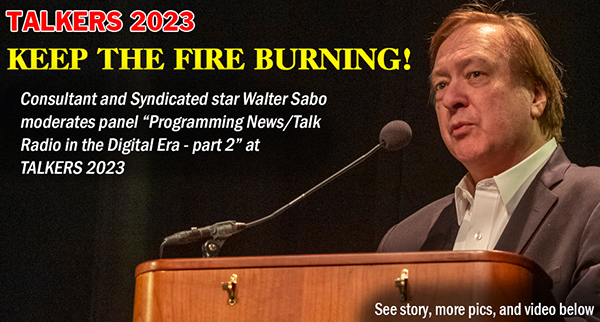
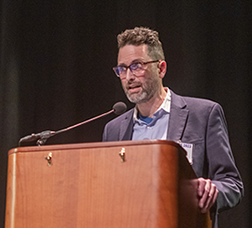 News/Talk Radio in the Digital Era – Part 2.” The session, sponsored by “Our American Stories,” is introduced by Alex Fife, VP operations, Southeast, iHeartMedia – Total Traffic & Weather Network (pictured at right) and moderated by Walter Sabo, CEO, Sabo Media and host (Walter Sterling) of Sterling on Sunday (pictured above). Panelists (pictured below from left to right) include Dan Mandis, program director and host, WTN-FM, Nashville; Ross Kaminsky, host KOA, Denver; Phil Boyce, SVP, spoken word format, Salem Media Group/ops VP, New York region/WMCA/AM 970; Josh Leng, CEO, Talk Media Network; and Matt Meany, program director, WABC, New York/Red Apple Media.
News/Talk Radio in the Digital Era – Part 2.” The session, sponsored by “Our American Stories,” is introduced by Alex Fife, VP operations, Southeast, iHeartMedia – Total Traffic & Weather Network (pictured at right) and moderated by Walter Sabo, CEO, Sabo Media and host (Walter Sterling) of Sterling on Sunday (pictured above). Panelists (pictured below from left to right) include Dan Mandis, program director and host, WTN-FM, Nashville; Ross Kaminsky, host KOA, Denver; Phil Boyce, SVP, spoken word format, Salem Media Group/ops VP, New York region/WMCA/AM 970; Josh Leng, CEO, Talk Media Network; and Matt Meany, program director, WABC, New York/Red Apple Media. 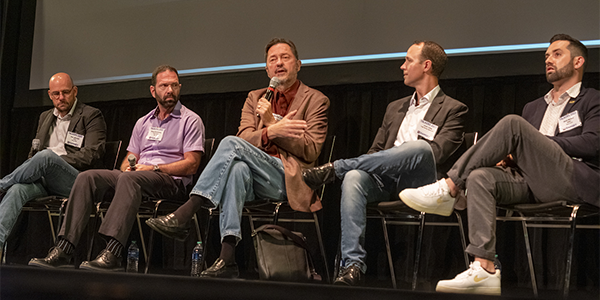
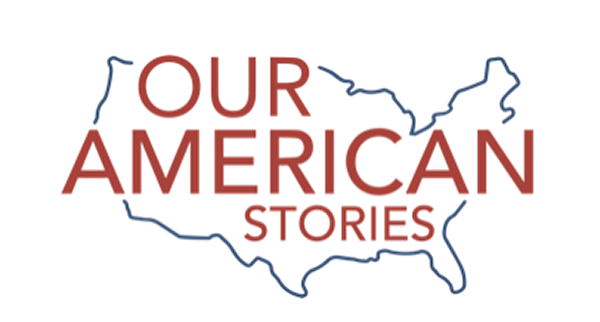
 Michael Harrison, founder and publisher of TALKERS, and the man who invented the term AOR – let’s not forget – strongly requested that I share this story about a remarkable event we experienced. Michael describes it as the “greatest promotion” he ever witnessed at a non-commercial function involving broadcasters… so I really have no choice but to accommodate him.
Michael Harrison, founder and publisher of TALKERS, and the man who invented the term AOR – let’s not forget – strongly requested that I share this story about a remarkable event we experienced. Michael describes it as the “greatest promotion” he ever witnessed at a non-commercial function involving broadcasters… so I really have no choice but to accommodate him.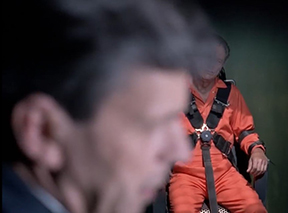 biography. I wrote him a letter inviting him to fly to New York to perform the scene live at our anniversary lunch at the National Arts Club. Two appealing prospects: Manhattan and the famous Club on Gramercy Park. Shockingly, he actually called and said if I would also fly his girlfriend in, he would do it! HE WOULD DO IT. Crap, now I had to do everything else. Invite all 200 wedding guests, stage a show, and not tell anyone that it was going to happen. Katie did not know.
biography. I wrote him a letter inviting him to fly to New York to perform the scene live at our anniversary lunch at the National Arts Club. Two appealing prospects: Manhattan and the famous Club on Gramercy Park. Shockingly, he actually called and said if I would also fly his girlfriend in, he would do it! HE WOULD DO IT. Crap, now I had to do everything else. Invite all 200 wedding guests, stage a show, and not tell anyone that it was going to happen. Katie did not know. A beautiful night. Paul Galvin and William Lear took their girlfriends to a romantic look-out view. Paul asked, “Isn’t this great?” His girlfriend replied, “It would better if we could hear music.”
A beautiful night. Paul Galvin and William Lear took their girlfriends to a romantic look-out view. Paul asked, “Isn’t this great?” His girlfriend replied, “It would better if we could hear music.”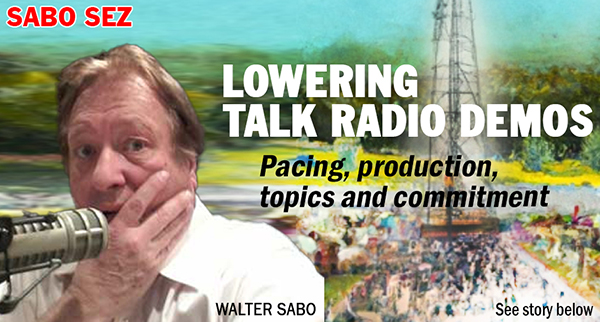
 The decision to change WABC from music to talk back in 1982 was not made by corporate, it was made by its then-program director, Jay Clark. Corporate was hoping he would approve the change, “they” lobbied for it, but the call was the ultimate responsibility of the program director. The business plan for WABC as a talk station predicted it to be profitable in year 10. (That’s because KABC, Los Angeles took 10 years to turn a profit.) As it turned out, WABC turned a profit in year 11.
The decision to change WABC from music to talk back in 1982 was not made by corporate, it was made by its then-program director, Jay Clark. Corporate was hoping he would approve the change, “they” lobbied for it, but the call was the ultimate responsibility of the program director. The business plan for WABC as a talk station predicted it to be profitable in year 10. (That’s because KABC, Los Angeles took 10 years to turn a profit.) As it turned out, WABC turned a profit in year 11. The whining is non-stop. Many in radio mourn the advent of consolidation, corporate dictates, staff cuts. They miss the way the industry was – before.
The whining is non-stop. Many in radio mourn the advent of consolidation, corporate dictates, staff cuts. They miss the way the industry was – before. A shocking number of highly qualified broadcasters have lost their jobs. The venture capitalists that financed the big radio companies are the people who should be fired, but that’s the next column. Let’s get you a job.
A shocking number of highly qualified broadcasters have lost their jobs. The venture capitalists that financed the big radio companies are the people who should be fired, but that’s the next column. Let’s get you a job.